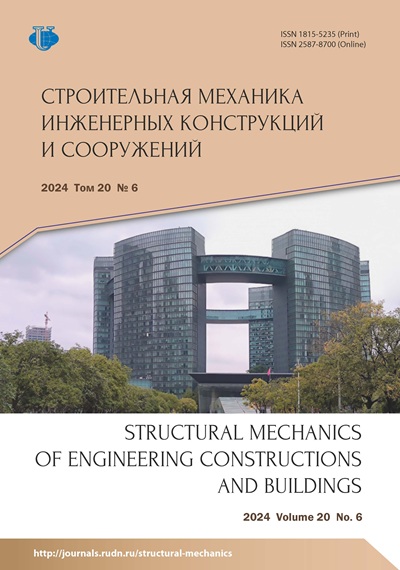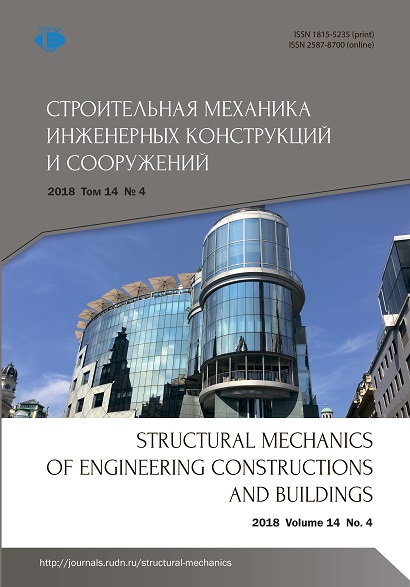Stress-strain state investigation of the “YASUNI” shell by bionic architecture methods based on numerical modeling
- Authors: Alyoshina O.О1, Cajamarca Zuniga D.2
-
Affiliations:
- Peoples’ Friendship University of Russia (RUDN University)
- Catholic University of Cuenca, Ecuador
- Issue: Vol 14, No 4 (2018)
- Pages: 273-277
- Section: Analysis and design of building structures
- URL: https://journals.rudn.ru/structural-mechanics/article/view/19275
- DOI: https://doi.org/10.22363/1815-5235-2018-14-4-273-277
Cite item
Full Text
Abstract
Full Text
Introduction It is hard to imagine architecture and construction without large-span shells of various applications [1] and taking into consideration the requests of architects, the new achievements in numeral modeling of the surfaces and introduction of new groups of tailored surfaces [2]. The appearance of new forms and types of thin-walled shell structures of this kind is inevitable. The bionic method of solving these tasks extends the limits of these opportunities [3]. Young architect Jose Pesantez from Catholic University of Cuenca has created two types of new forms of uncanonical bionic shell “YASUNI”: a wooden rod structure covered with a tent and a cast-in-place concrete shell. This pavilion structure is planned to be erected in the city park of Cuenca (Ecuador). Description and calculation of shell The form of the shell imitates a leaf of a flower laying on the lay of the land. The triangular finiteelement mesh is created with a harmonic fusion of lily and daisy in a single structure (Fig. 1) [4]. Only stress-strain state of the cast-in-place concrete shell is investigated in this article. Stress-strain state of the shell depends on the boun- dary conditions, with or without contour elements, the type of the external load - static, wind or seismic. The of finite elements analysis [5], implemented with the computer software SCAD [6], which allows to find out the regularity of the work of the building and take into consideration all the features of the structural concept, is used to define the reaction of the construction to the load and to estimate the most distinctive geometrical parameters of this shell. Alyoshina O.O., Cajamarca Zuniga D. Structural Mechanics of Engineering Constructions and Buildings, 2018, 14(4), 273-277 The overall view of the calculation model with the approximation of the middle surface by complex of flat triangle elements is shown in the figs. 2 and 3 [7]. Figure 1. “YASUNI” shell Geometrical overall dimensions of the scheme in the plan are 17.3×5 m, shell depth is 2.3 m, fourpoint support with rigid fixing. The size of the side of finite triangle elements is from 0.1 m to 0.4 m. The number of the triangle elements is 3438, joints 1813. The shell is designed as a solid-cast one, made of different classes of reinforced concrete (В25, В30, В35) with thickness between δ = 5 cm and δ = 10 cm with a step 1 cm without contouring beams. The structure is estimated to withstand only its self-weight. Some of the results of analysis for a shell with thickness of δ = 5 cm, class of concrete В25 are listed in the figs. 4-7. Figure 2. Design model. View А Figure 3. Design model. View B Figure 4. Vertical displacements (cm) Figure 5. Normal stress Nx (kN/m2) Алёшина О.О., Кахамарка-Сунига Д. Строительная механика инженерных конструкций и сооружений. 2018. Т. 14. № 4. С. 273-277 Figure 7. Bending moment Му (kNm/m) The displacement of the console part of the shell is 5 mm. The maximum displacement between the sup- ports is 13 mm. The isofields of bending moment Мх shows that the shell works in the beam scheme in this direction. The rate of the maximum bending moment Мх in the span between the supports is 2.1 kNm/m. In the console part, the rate of bending moment Мх ranges from -0.24 kNm/m to 0.54 kNm/m. Maximum vertical displacements due to the shell self-weight are presented in the table 1. The general pattern of distribution of isofields displacements for various thickness is analogous. Table 1 Thick ness δ (cm) Мах vertical displacement (cm), class of concrete В25 Мах vertical displacement (cm), class of concrete В30 Мах vertical displacement (cm), class of concrete В35 10 -0,42 -0,39 -0,37 9 -0,51 -0,47 -0,44 8 -0,62 -0,57 -0,53 7 -0,77 -0,71 -0,67 6 -0,99 -0,91 -0,86 5 -1,32 -1,22 -1,15 The value of normal stresses Nx, Ny, shear forces Qx, Qy, bending moments Mx, My in the shell of the same thickness are similar for the different classes of concrete. When the thickness of the shell made of specific class of concrete is increased, the normal stresses Nx and Ny decrease, the values shear forces Qx, Qy and bending moments Mx, My increase. Conclusion The article presents the first results of stressstrain state investigation of the “YASUNI” shell. The authors continue research on this shell with different geometrical parameters, the boundary conditions with the addition of contour elements. The computer software SCAD allows to reach the most advantageous technical-and-economic indexes of the investigated shell of complexed geometry.About the authors
Olga О Alyoshina
Peoples’ Friendship University of Russia (RUDN University)
Author for correspondence.
Email: xiaofeng@yandex.ru
Civil Engineering Ph.D. student, Department of Civil Engineering, Engineering Academy, Peoples’ Friendship University of Russia (RUDN Univer- sity). Scientific interests: theory of thin elastic shells, computer modeling, assessment of the stress-strain state. 6 Mikluho-Maklaya St., Moscow, 117198, Russian Federation
David Cajamarca Zuniga
Catholic University of Cuenca, Ecuador
Email: cdavidcz@hotmail.com
Engineer, M.Sc., Associate Professor of the Department of Bridges and the Department of Structural Analysis, Catholic University of Cuenca. Scientific interests: large-span structures, bridges, high-strength and ultra-high-strength concrete, fiber-reinforced concrete, seismic resistance of structures, inspection and diagnostics of structures, analysis of strain-stress state of structures 288 Av. Don Bosco, Cuenca, 0101114, Ecuador
References
- Krivoshapko S.N., Mamieva I.A. (2012). Vydayushchiesya prostranstvennye sooruzheniya poslednih 20 let [Outstanding wide-span spatial structures of last 20 years]. Montazhnye i special'nye raboty v stroitel'stve [Installation and special works in construction], (12), 8-14. (In Russ.)
- Krivoshapko S.N., Ivanov V.N. (2015). Encyclopedia of Analytical Surfaces. Springer International Publishing Switzerland, 752. Alyoshina O.O., Cajamarca Zuniga D. Structural Mechanics of Engineering Constructions and Buildings, 2018, 14(4), 273-277
- Lebedev Y.S., Rabinovich V.I., Polozhay E.D., et al. (1990). Arhitekturnaya bionika [Architectural Bionics]. Moscow: Strojizdat Publ., 269. (In Russ.)
- Doczi G. (2006). El poder de los límites: proporciones armónicas en la naturaleza, el arte y la arquitectura. Buenos Aires: Editorial Troquel
- Rozin L.A., Gordon L.A. (1971). Metod konechnyh ehlementov v teorii plastin i obolochek. [Finite element method in the theory of plates and shells]. Izvestiya VNIIG, (95), 85-97. (In Russ.)
- Karpilovskij V.S., Kriksunov Eh.Z., Malyarenko A.A., Perel'muter A.V., Fialko S.Yu. (2015). SCAD Office. Versiya 21. Vychislitel'nyj kompleks SCAD++ [SCAD Office. Version 21. System SCAD++]. Moscow: SKAD SOFT Publ., 848. (In Russ.)
- Larry J. Segerlind. (1984). Applied Finite Element Analysis. Second Edition. New York, John Wiley & Sons.















